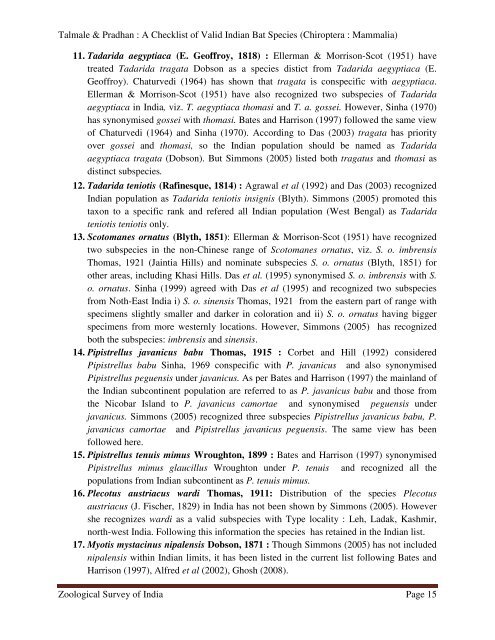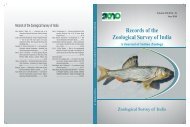A Checklist of Valid Indian Bat Species - Zoological Survey of India
A Checklist of Valid Indian Bat Species - Zoological Survey of India
A Checklist of Valid Indian Bat Species - Zoological Survey of India
Create successful ePaper yourself
Turn your PDF publications into a flip-book with our unique Google optimized e-Paper software.
Talmale & Pradhan : A <strong>Checklist</strong> <strong>of</strong> <strong>Valid</strong> <strong><strong>India</strong>n</strong> <strong>Bat</strong> <strong>Species</strong> (Chiroptera : Mammalia)<br />
11. Tadarida aegyptiaca (E. Ge<strong>of</strong>froy, 1818) : Ellerman & Morrison-Scot (1951) have<br />
treated Tadarida tragata Dobson as a species distict from Tadarida aegyptiaca (E.<br />
Ge<strong>of</strong>froy). Chaturvedi (1964) has shown that tragata is conspecific with aegyptiaca.<br />
Ellerman & Morrison-Scot (1951) have also recognized two subspecies <strong>of</strong> Tadarida<br />
aegyptiaca in <strong>India</strong>, viz. T. aegyptiaca thomasi and T. a. gossei. However, Sinha (1970)<br />
has synonymised gossei with thomasi. <strong>Bat</strong>es and Harrison (1997) followed the same view<br />
<strong>of</strong> Chaturvedi (1964) and Sinha (1970). According to Das (2003) tragata has priority<br />
over gossei and thomasi, so the <strong><strong>India</strong>n</strong> population should be named as Tadarida<br />
aegyptiaca tragata (Dobson). But Simmons (2005) listed both tragatus and thomasi as<br />
distinct subspecies.<br />
12. Tadarida teniotis (Rafinesque, 1814) : Agrawal et al (1992) and Das (2003) recognized<br />
<strong><strong>India</strong>n</strong> population as Tadarida teniotis insignis (Blyth). Simmons (2005) promoted this<br />
taxon to a specific rank and refered all <strong><strong>India</strong>n</strong> population (West Bengal) as Tadarida<br />
teniotis teniotis only.<br />
13. Scotomanes ornatus (Blyth, 1851): Ellerman & Morrison-Scot (1951) have recognized<br />
two subspecies in the non-Chinese range <strong>of</strong> Scotomanes ornatus, viz. S. o. imbrensis<br />
Thomas, 1921 (Jaintia Hills) and nominate subspecies S. o. ornatus (Blyth, 1851) for<br />
other areas, including Khasi Hills. Das et al. (1995) synonymised S. o. imbrensis with S.<br />
o. ornatus. Sinha (1999) agreed with Das et al (1995) and recognized two subspecies<br />
from Noth-East <strong>India</strong> i) S. o. sinensis Thomas, 1921 from the eastern part <strong>of</strong> range with<br />
specimens slightly smaller and darker in coloration and ii) S. o. ornatus having bigger<br />
specimens from more westernly locations. However, Simmons (2005) has recognized<br />
both the subspecies: imbrensis and sinensis.<br />
14. Pipistrellus javanicus babu Thomas, 1915 : Corbet and Hill (1992) considered<br />
Pipistrellus babu Sinha, 1969 conspecific with P. javanicus and also synonymised<br />
Pipistrellus peguensis under javanicus. As per <strong>Bat</strong>es and Harrison (1997) the mainland <strong>of</strong><br />
the <strong><strong>India</strong>n</strong> subcontinent population are referred to as P. javanicus babu and those from<br />
the Nicobar Island to P. javanicus camortae and synonymised peguensis under<br />
javanicus. Simmons (2005) recognized three subspecies Pipistrellus javanicus babu, P.<br />
javanicus camortae and Pipistrellus javanicus peguensis. The same view has been<br />
followed here.<br />
15. Pipistrellus tenuis mimus Wroughton, 1899 : <strong>Bat</strong>es and Harrison (1997) synonymised<br />
Pipistrellus mimus glaucillus Wroughton under P. tenuis and recognized all the<br />
populations from <strong><strong>India</strong>n</strong> subcontinent as P. tenuis mimus.<br />
16. Plecotus austriacus wardi Thomas, 1911: Distribution <strong>of</strong> the species Plecotus<br />
austriacus (J. Fischer, 1829) in <strong>India</strong> has not been shown by Simmons (2005). However<br />
she recognizes wardi as a valid subspecies with Type locality : Leh, Ladak, Kashmir,<br />
north-west <strong>India</strong>. Following this information the species has retained in the <strong><strong>India</strong>n</strong> list.<br />
17. Myotis mystacinus nipalensis Dobson, 1871 : Though Simmons (2005) has not included<br />
nipalensis within <strong><strong>India</strong>n</strong> limits, it has been listed in the current list following <strong>Bat</strong>es and<br />
Harrison (1997), Alfred et al (2002), Ghosh (2008).<br />
<strong>Zoological</strong> <strong>Survey</strong> <strong>of</strong> <strong>India</strong> Page 15

















